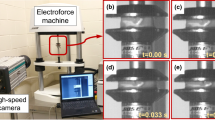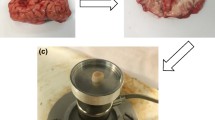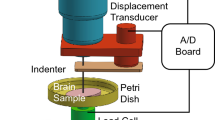Abstract
The understanding of the mechanical behavior of the brain tissue is essential to prevent the occurrence of potential brain damage, such as traumatic brain injury. Recent experimental results showed that brain tissue exhibits significant tension/compression asymmetry. Due to the migration and diffusion of interstitial fluid, brain tissue also shows a moderate volume compressibility during loading. These mechanical characteristics have a strong impact on the deformation response of brain tissue. In this paper, a visco-hyperelastic constitutive model incorporating both tension/compression asymmetry and volume compressibility is proposed to describe the mechanical behavior of brain tissue under various loading modes. An Ogden-type model with the addition of a viscoelastic part is used to characterize the tension/compression asymmetry as well as the viscoelastic properties. Poisson’s ratio was introduced as a phenomenological index to represent the total volume change as well as the compressibility/recoverability. The mechanical responses of brain tissue under uniaxial tension, unconfined compression, stress relaxation, and cyclic compression were reproduced with a good capture of the tension/compression asymmetry, volume compressibility, significant viscoelastic properties, and cyclic hysteresis behaviors. The good agreement with the experimental data implies that the proposed model has a strong capability to describe the complex mechanical performance of brain tissue under a variety of loading conditions.
Similar content being viewed by others
References
Taylor, C.A., Bell, J.M., Breiding, M.J., Xu, L.: Traumatic brain injury–related emergency department visits, hospitalizations, and deaths-united states, 2007 and 2013. MMWR Surveill Summ. 66(SS-9), 1–16 (2017)
Miller, K., Chinzei, K.: Mechanical properties of brain tissue in tension. J. Biomech. 35(4), 483–490 (2002)
Zhang, W., Zhang, R.R., Wu, F., Feng, L.I., Yu, S.B., CW, Wu: Differences in the viscoelastic features of white and grey matter in tension. J. Biomech. 49(16), 3990–3995 (2016)
Labus, K.M., Puttlitz, C.M.: Viscoelasticity of brain corpus callosum in biaxial tension. J. Mech. Phys. Solids 96, 591–604 (2016)
Pervin, F., Chen, W.W.: Dynamic mechanical response of bovine gray matter and white matter brain tissues under compression. J. Biomech. 42(6), 731–735 (2009)
Prevost, T.P., Balakrishnan, A., Suresh, S., Socrate, S.: Biomechanics of brain tissue. Acta Biomat. 7(1), 83–95 (2011)
Bilston, L.E., Liu, Z., Phan-Thien, N.: Linear viscoelastic properties of bovine brain tissue in shear. Biorheology 34(6), 377–385 (1997)
Rashid, B., Destrade, M., Gilchrist, M.D.: Mechanical characterization of brain tissue in simple shear at dynamic strain rates. J. Mech. Behav. Biomed. 28, 71–85 (2013)
Moran, R., Smith, J.H., García, J.J.: Fitted hyperelastic parameters for human brain tissue from reported tension, compression, and shear tests. J. Biomech. 47(15), 3762–3766 (2014)
Destrade, M., Gilchrist, M., Murphy, J.G., Rashid, B., Saccomandi, G.: Extreme softness of brain matter in simple shear. Int. J. Nonlin. Mech. 75, 54–58 (2015)
Li, G., Zhang, J., Wang, K., Wang, M., Gao, C., Ma, C.: Experimental research of mechanical behavior of porcine brain tissue under rotational shear stress. J. Mech. Behav. Biomed. 57, 224–234 (2016)
Balakrishnan, A.: Development of novel dynamic indentation techniques for soft tissue applications. Ph.D. thesis. https://dspace.mit.edu/handle/1721.1/429872007. (2007)
Van Dommelen, J., Van der Sande, T., Hrapko, M., Peters, G.: Mechanical properties of brain tissue by indentation: interregional variation. J. Mech. Behav. Biomed. Mater. 3(2), 158–166 (2010)
Prevost, T.P., Jin, G., De Moya, M.A., Alam, H.B., Suresh, S., Socrate, S.: Dynamic mechanical response of brain tissue in indentation in vivo, in situ and in vitro. Acta Biomat. 7(12), 4090–4101 (2011)
Budday, S., Nay, R., de Rooij, R., Steinmann, P., Wyrobek, T., Ovaert, T.C., Kuhl, E.: Mechanical properties of gray and white matter brain tissue by indentation. J. Mech. Behav. Biomed. Mater. 46, 318–330 (2015)
MacManus, D.B., Pierrat, B., Murphy, J.G., Gilchrist, M.D.: A viscoelastic analysis of the P56 mouse brain under large-deformation dynamic indentation. Acta Biomat. 48, 309–318 (2017)
Feng, Y., Lee, C.H., Sun, L., Ji, S., Zhao, X.: Characterizing white matter tissue in large strain via asymmetric indentation and inverse finite element modeling. J. Mech. Behav. Biomed. Mater. 65, 490–501 (2017)
Budday, S., Sommer, G., Birkl, C., Langkammer, C., Haybaeck, J., Kohnert, J., Bauer, M., Paulsen, F., Steinmann, P., Kuhl, E.: Mechanical characterization of human brain tissue. Acta Biomat. 48, 319–340 (2017)
Pogoda, K., Chin, L., Georges, P.C., Byfield, F.J., Bucki, R., Kim, R., Weaver, M., Wells, R.G., Marcinkiewicz, C., Janmey, P.A.: Compression stiffening of brain and its effect on mechanosensing by glioma cells. New J. Phys. 16(7), 075002 (2014)
Mihai, L.A., Chin, L., Janmey, P.A., Goriely, A.: A comparison of hyperelastic constitutive models applicable to brain and fat tissues. J. R. Soc. Interface 12(110), 20150486 (2015)
Mihai, L.A., Budday, S., Holzapfel, G.A., Kuhl, E., Goriely, A.: A family of hyperelastic models for human brain tissue. J. Mech. Phys. Solids 106, 60–79 (2017)
Lodish, H.: Molecular Cell Biology, 6th edn. Macmillan, New York (2008)
de Rooij, R., Kuhl, E.: Constitutive modeling of brain tissue: current perspectives. Appl. Mech. Rev. 68(1), 010801 (2016)
Shuck, L.Z., Advani, S.H.: Rheological response of human brain tissue in shear. J. Basic Eng. 94, 905–911 (1972)
Jenson, D., Unnikrishnan, V.U.: Energy dissipation of nanocomposite based helmets for blast-induced traumatic brain injury mitigation. Compos. Struct. 121, 211–216 (2015)
Hrapko, M., Van Dommelen, J., Peters, G., Wismans, J.: The mechanical behaviour of brain tissue: large strain response and constitutive modelling. Biorheology 43(5), 623–636 (2006)
Bilston, L.E., Liu, Z., Phan-Thien, N.: Large strain behaviour of brain tissue in shear: some experimental data and differential constitutive model. Biorheology 38(4), 335–345 (2001)
Cloots, R., Van Dommelen, J., Nyberg, T., Kleiven, S., Geers, M.: Micromechanics of diffuse axonal injury: influence of axonal orientation and anisotropy. Biomech. Model. Mechan. 10(3), 413–422 (2011)
Laksari, K., Shafieian, M., Darvish, K.: Constitutive model for brain tissue under finite compression. J. Biomech. 45(4), 642–646 (2012)
Ogden, R.W.: Large deformation isotropic elasticity-on the correlation of theory and experiment for incompressible rubberlike solids. Proc. R. Soc. Lond. A 326, 565–584 (1972)
Mendis, K., Stalnaker, R., Advani, S.: A constitutive relationship for large deformation finite element modeling of brain tissue. J. Biomech. Eng. 117(3), 279–285 (1995)
Miller, K., Chinzei, K.: Constitutive modelling of brain tissue: experiment and theory. J. Biomech. 30(11), 1115–1121 (1997)
Prange, M.T., Margulies, S.S.: Regional, directional, and age-dependent properties of the brain undergoing large deformation. J. Biomech. Eng. 124(2), 244–252 (2002)
Budday, S., Sommer, G., Hayback, J., Steinmann, P., Holzapfel, G.A., Kuhl, E.: Rheological characterization of human brain tissue. Acta Biomat. 60, 315–329 (2017)
Budday, S., Sommer, G., Holzapfel, G.A., Steinmann, P., Kuhl, E.: Viscoelastic parameter identification of human brain tissue. J. Mech. Behav. Biomed. Mater. 74, 463–476 (2017)
Haslach Jr., H.W., Leahy, L.N., Riley, P., Gullapalli, R., Xu, S., Hsieh, A.H.: Solid-extracellular fluid interaction and damage in the mechanical response of rat brain tissue under confined compression. J. Mech. Behav. Biomed. Mater. 29, 138–150 (2014)
Grandjean, A.C., Grandjean, N.R.: Dehydration and cognitive performance. J. Am. Coll. Nutr. 26(5), 549S–554S (2007)
Yoon, J., Cai, S., Suo, Z., Hayward, R.C.: Poroelastic swelling kinetics of thin hydrogel layers: comparison of theory and experiment. Soft Matter 6(23), 6004–6012 (2010)
Wang, Q.-M., Mohan, A.C., Oyen, M.L., Zhao, X.-H.: Separating viscoelasticity and poroelasticity of gels with different length and time scales. Acta Mech. Sinica-PRC 30(1), 20–27 (2014)
Hu, Y., Suo, Z.: Viscoelasticity and poroelasticity in elastomeric gels. Acta Mech. Solida Sin. 25(5), 441–458 (2012)
Kaczmarek, M., Subramaniam, R.P., Neff, S.R.: The hydromechanics of hydrocephalus: steady-state solutions for cylindrical geometry. B. Math. Biol. 59, 295–323 (1997)
Kyriacou, S.K., Mohamed, A., Miller, K., Neff, S.: Brain mechanics for neurosurgery: modeling issues. Biomech. Model. Mechan. 1, 151–164 (2002)
Ames, N.M.: An internal variable theory for isotropic visco-elastic-plastic solids: application to indentation of amorphous polymeric solids. Master thesis. https://dspace.mit.edu/handle/1721.1/33162. (2003)
Anand, L., Ames, N.: On modeling the micro-indentation response of an amorphous polymer. Int. J. Plasticity 22(6), 1123–1170 (2006)
Voyiadjis, G.Z., Samadi-Dooki, A.: Hyperelastic modeling of the human brain tissue: effects of no-slip boundary condition and compressibility on the uniaxial deformation. J. Mech. Behav. Biomed. Mater. 83, 63–78 (2018)
Kleiven, S.: Predictors for traumatic brain injuries evaluated through accident reconstructions (No. 2007-22-0003). SAE Technical Paper. (2007)
Wang, R., Sarntinoranont, M.: Biphasic analysis of rat brain slices under creep indentation shows nonlinear tension-compression behavior. J. Mech. Behav. Biomed. Mater. 89, 1–8 (2019)
Samadidooki, A.: Experimental, Analytical, and Numerical Evaluation of the Mechanical Properties of the Brain Tissue. Doctoral thesis. https://digitalcommons.lsu.edu/gradschool_dissertations/4622/. (2018)
Abdulhafez, M., Kadry, K., Zaazoue, M., Goumnerova, L.C., Bedewy, M.: Biomechanical root cause analysis of complications in head immobilization devices for pediatric neurosurgery. In: ASME 2018 13th International Manufacturing Science and Engineering Conference (pp. V001T05A007-V001T05A007). American Society of Mechanical Engineers. (2018)
Viano, D.C., Casson, I.R., Pellman, E.J., Zhang, L., King, A.I., Yang, K.H.: Concussion in professional football: brain responses by finite element analysis: part 9. Neurosurgery 57(5), 891–916 (2005)
Gu, L., Chafi, M.S., Ganpule, S., Chandra, N.: The influence of heterogeneous meninges on the brain mechanics under primary blast loading. Compos. Part B- Eng. 43(8), 3160–3166 (2012)
Nolan, D., Gower, A., Destrade, M., Ogden, R., McGarry, J.: A robust anisotropic hyperelastic formulation for the modelling of soft tissue. J. Mech. Behav. Biomed. Mater. 39, 48–60 (2014)
Acknowledgements
This work was supported by the National Natural Science Foundation of China (Grant No. 11472231, 11872322) and partially supported by Doctoral Innovation Fund Program of Southwest Jiaotong University (Grant No. D-CX201835).
Author information
Authors and Affiliations
Corresponding author
Additional information
Publisher's Note
Springer Nature remains neutral with regard to jurisdictional claims in published maps and institutional affiliations.
Rights and permissions
About this article
Cite this article
Zhu, Z., Jiang, C. & Jiang, H. A visco-hyperelastic model of brain tissue incorporating both tension/compression asymmetry and volume compressibility. Acta Mech 230, 2125–2135 (2019). https://doi.org/10.1007/s00707-019-02383-1
Received:
Revised:
Published:
Issue Date:
DOI: https://doi.org/10.1007/s00707-019-02383-1




